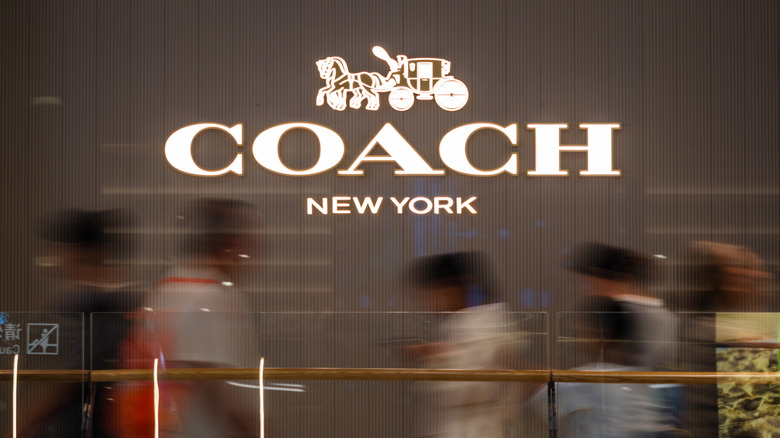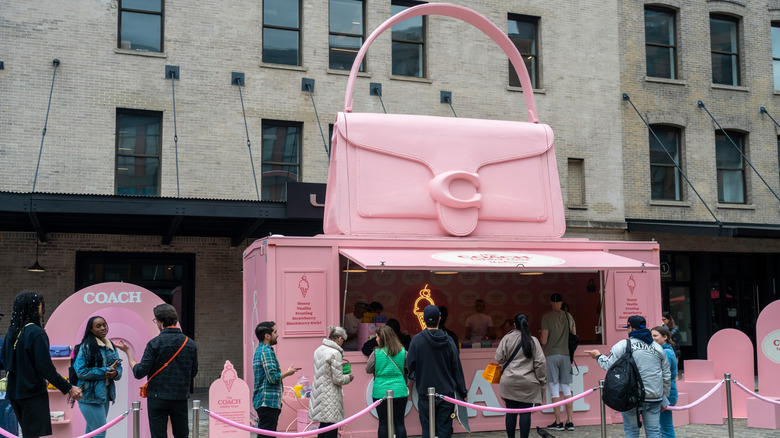Why Shopping At Coach Can Be A Status Symbol For Some Americans
For many shoppers, the only way to own a luxury-style bag is to buy a similar design made with cheaper materials. "Dupe" bags — like the under-$30 Christian Dior-esque bags or a bargain-basement Bottega alternative at Walmart — can cost thousands less than the real deal. However, some shoppers seek a more expensive, but still affordable, status symbol bag. They desire a high-end item that fits a mid-tier budget, prioritizing buttery leather, a big name, and a bigger price tag. These purse fiends crave Coach.
Founded in New York City in 1941,Coach has long made a name for itself as an affordable, or at least accessible, luxury bag. Coach bags were extremely popular in the 1990s, and their popularity is rising again today. Prices range from a little over $100 to just under $1,000, with styles like the Tabby, Lana, and Ergo available. Coach bags are carried proudly by celebrities like Jennifer Lopez, Selena Gomez, and Megan Thee Stallion.
Coach bags are especially popular among Gen Z shoppers looking to get their hands on Y2K fashion, not to mention an attention-grabbing social media post. These bags are also a way that some Americans can still aspire to afford an item that embodies quality and luxury, even while prices climb. With most Coach bags priced under $1,000, it remains far cheaper than ultra-high-end brands, which continue to raise prices.
Generations of Coach shoppers
A generational appreciation for a good deal may have helped keep Coach bags in the sweet status symbol bag spot. For today's Gen Z shoppers, a Coach bag may be something they remember their parents buying when they were younger. Now that those shoppers have grown into a major purchasing power, they crave the nearby luxury of a quality-made Coach bag.
Despite being cheaper than a top-end Hermès bag — which holds its value better than gold – a Coach bag isn't exactly a steal for most shoppers. However, a price point of around $450 to $650 for something in Coach's Tabby collection may create enough high-status distance on a mid-tier budget for most younger shoppers coveting such a symbol. Even proudly displaying a $179 Coach Nolita 19 might be enough for status symbol-hungry shoppers to divide themselves from the rest of the crowd that are otherwise happy to buy designer dupes for dollars.
Gen Z shoppers keep the collectible craze stoked for themselves and others by posting their finds on social media posts and in TikTok videos. Even as their purchases drive the stock and revenue beyond projections for its parent company, Tapestry, Gen Z shoppers may love one thing even more than a full-price bag: a thrifted Coach purchase.
The changing price of quality
Coach's current status as an affordable "it" bag may have made its way back into cultural prominence from someplace not so luxurious: the thrift store. Gen Z shoppers longing for all '90s trends have been hunting bargain bins for high-quality items. With some light retooling and cleaning, thrift store shoppers can score a vintage Coach bag for cheaper than any Amazon-sold dupe.
Most luxury bags have continued to raise prices, and still will under ever-increasing tariffs. Coach raises prices, but their usual under-$1,000 price points help mask costs and keep customers interested. The brand has also invested in young stars to lead its advertising campaigns, from Camila Mendes to Elle Fanning. Usually known for subdued colorways and more elegant designs, Coach has adopted a "sticker" pattern as well as fun dinosaurs and prints for bags that beg for a clip-on Labubu.
While some may be able to snag a Y2K-era Coach tote with just $10 and knowledge of the best days to shop at the thrift store, the company isn't counting on thrift store interest to keep driving its revenue. Coach has invested in adding coffee shops to several stores to attract Gen Z shoppers and lure younger generations. This type of experience draws customers into the stores and helps reinforce the brand's status-symbol appeal without the need to spend hundreds on bags. As Marc Sanders, Coach's vice president of global food and beverage, told CNBC when discussing shopper experiences: "You can afford a coffee more often."


